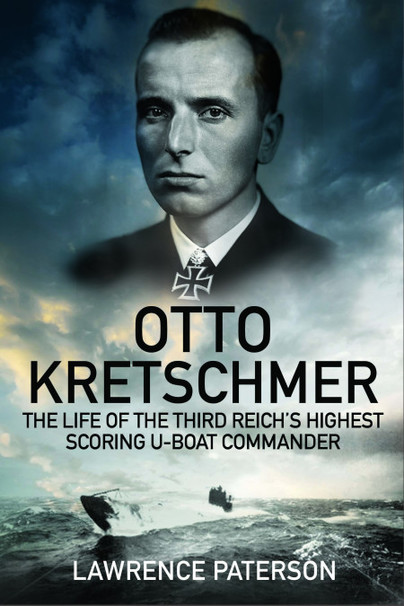
Otto Kretschmer: The Life of the Third Reich’s Highest Scoring U-boat Commander. By Lawrence Paterson
Pen and Sword, Barnsley, 2018.
Reviewed by John Johnston.
SINKING or damaging over 300,000 tons of British, allied, and neutral shipping between the outbreak of war in September 1939 and his capture in March 1941 made Otto Kretschmer the Tonnenkönig or tonnage king of the German U-boat service in the Second World War.
As a prisoner, Kretschmer tried to maintain the honour of a German officer and engaged in numerous acts of resistance to those guarding him. Repatriated to Germany in 1947, he joined the Bundesmarine, the navy of West Germany when it was formed in 1955 and remained in service until his retirement as a Flotillenadmiral or commodore in 1970. Thereafter, his life was quiet and uneventful, except for some notoriety shortly before his death in 1998 through involvement with a pseudo-historical neo-Nazi organisation.
In recounting Kretschmer’s life and career, Lawrence Paterson updates an earlier biography, The golden horseshoe, that was written by Terence Robertson in 1955. Paterson has removed interviews whose veracity cannot be established and explores Kretschmer’s career as a U-boat commander in part through materials that were not available to Robertson. He uses war diaries, for example, to trace the patrols Kretschmer’s boats, U-23 and U-99 undertook in the North Sea and the eastern Atlantic and illustrates the narrative with charts which Kretschmer included in his after action reports to the U-boat high command. The diaries and reports also show the evolution of U-boat tactics during the first eighteen months of the war and the technical deficiencies which, fortunately for the allies, made the boats less effective than they could have been.
Kretschmer particularly criticised the approved tactic of attacking a convoy by firing several torpedoes in a fan from beyond the escort screen because this was ineffective and wasted ammunition. Instead, he argued for going submerged under a convoy’s escort screen and surfacing among the merchantmen to engage them individually at close range with torpedoes and gunfire. The manoeuvre risked detection whilst passing through the escort screen and being rammed once among the merchantmen, whilst performing it required levels of seamanship, navigation, and technical skill that could only be found in well-practised and highly cohesive teams. There was no doubting the ability of Kretschmer and fellow aces like Günther Prien and Joachim Schepke to create such teams, but the teams could not be replaced easily if they were lost, and by early 1941 the Kriegsmarine had begun concentrating U-boats into centrally coordinated and controlled wolf packs. Kretschmer objected to this development, but ultimately wolf pack tactics would inflict greater damage to allied shipping than aces like him could have achieved individually.
Kretschmer’s story now shifted to prisoner of war cages and camps in England and Canada. His rank – Korvettenkapitän or commander and later Frigattenkapitän or captain – and his status as holder of the knight’s cross with oak leaves gave him seniority and respect among his fellow prisoners. He participated in courts of honour in England to try those whose conduct fell below that expected of German officers, orchestrated a riot at Bowmanville, Ontario when the Canadians attempted to shackle German prisoners in retaliation for the shackling of Canadian prisoners at Dieppe, and subsequently organised escape attempts from the Bowmanville camp. Such actions, one of which had led to the death of a fellow prisoner, led to him not being released from captivity until 1947.
Whilst Paterson examines Kretschmer’s career as a U-boat commander and his experiences as a prisoner of war in some depth, his later career as an officer of the Bundesmarine and his apparently unwitting involvement with a neo-Nazi group are passed over in a few paragraphs. Paterson hints at tensions in the 1950s with doctrines of internal leadership and the citizen in uniform that were alien to the concepts of subordination to authority and military autonomy that Kretschmer and his fellow officers would have experienced in the Reichswehr and the Wehrmacht. Similarly, Kretschmer’s involvement, witting or unwitting, with neo-Nazi groupings parallels that of other officers of his generation and so raises a question of how far German nationalism was tolerated in the institutions of the Bonn Republic. The question is significant with the Berlin Republic renaming barracks that were given the names of Second World War commanders during the Bonn Republic because of a perception that the names were originally chosen to perpetuate now unacceptable traditions of nationalism and militarism.
These, however, are issues for another volume. This volume reveals much about the operations and tactics of the U-boat campaign during the first eighteen months of the war. The copious illustrations illuminate a text that is sometimes complex but which is always clearly written and easy to follow, while the range of sources – from oral history, through printed works and manuscript material, to clips of film, radio, and television interviews downloaded from the Internet – that Paterson draws together is itself astounding. Whilst entertaining for the general reader, this book will be a source of reference for those seeking information on vessels lost to U-boat attacks, the technicalities of operating a U-boat, or other aspects of the war at sea between 1939 and 1941.




Thank you for the review.
All the best.